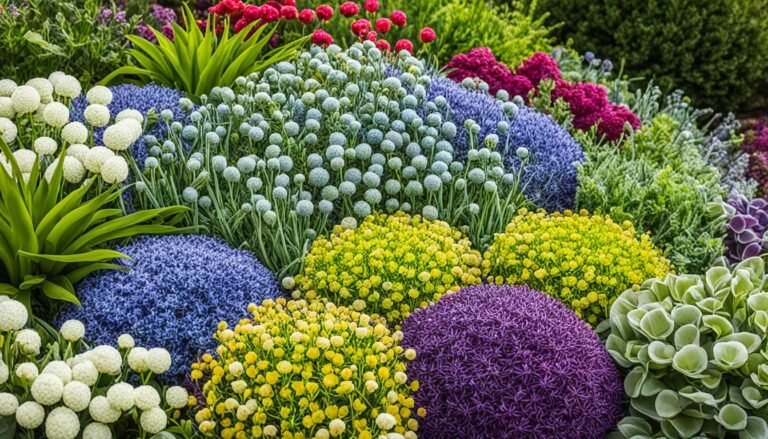As I strolled through the vibrant garden, I couldn’t help but be captivated by the array of ball-shaped flowers that filled the air with their delightful fragrance. The spherical blooms, with their round flower heads and globe-shaped blossoms, created a stunning display of nature’s artistry. These orb flowers, with their circular floral arrangements and sphere-like petals, were truly a sight to behold.
I paused to admire a cluster of flowery balls, their vibrant colors standing out against the lush green foliage. Each individual petal seemed to be carefully crafted, forming a perfect sphere that added a whimsical touch to the garden. As I got closer, I could see the intricate details and delicate textures that made these spherical floral displays so unique.
It was fascinating to learn about the wide variety of ball-shaped flowers available for gardeners to enjoy. From the towering stalks of alliums adorned with their round flower heads, to the cheerful dahlias with their ball-shaped pompom blooms, there was a ball-looking flower to suit every gardener’s taste.
- Ball-shaped flowers, also known as pom-pom flowers, are a unique and eye-catching addition to any garden.
- These flowers come in a wide range of colors, shapes, and sizes, making them versatile and suitable for all gardeners.
- Ball-shaped flowers offer benefits such as attracting pollinators and providing long-lasting blooms.
- Recommended ball-shaped flowers for your garden include alliums, dahlias, chrysanthemums, viburnum opulus, globe thistles, hydrangea arborescens annabelle, and Craspedia.
- Experiment with different varieties of ball-shaped flowers to add a touch of whimsy and beauty to your garden.
Alliums – My Favorite Ball-Shaped Flower
Alliums are stunning ball-shaped flowers that produce large round flower heads. They come in a variety of colors and sizes, making them a versatile choice for any garden. Alliums are low maintenance plants with long-lasting blooms that can bring beauty to your garden for weeks.
These enchanting flowers have the ability to attract pollinators such as bees and butterflies, making them beneficial to the overall ecosystem of your garden. Bees and butterflies are vital for pollination, and having alliums in your garden will create a desirable environment for these important creatures.
One popular variety of allium is called Purple Sensation which features rich purple flowers that add a touch of elegance and drama to any garden. However, alliums are available in a wide variety of colors, including white, pink, yellow, and shades of blue, allowing you to choose the perfect color to complement your garden’s aesthetic.
Not only are alliums visually stunning, but they also have the added advantage of being low maintenance plants. They require minimal care once established, making them suitable for gardeners of all experience levels. Alliums are deer and rabbit resistant, offering an attractive solution for those dealing with garden pests.
To summarize, alliums are beautiful ball-shaped flowers that offer a variety of colors and sizes. They require low maintenance and produce long-lasting blooms that can attract valuable pollinators to your garden. Consider planting alliums, such as the Purple Sensation variety, to bring color and life to your outdoor space.
Dahlias
When it comes to ball-shaped flowers, dahlias are a personal favorite of mine. Known for their stunning pompom-like blooms, dahlias come in a wide variety of colors and sizes, adding a touch of charm to any garden. Whether you choose the dinnerplate variety with its large, dinner-sized flowers or the more compact ball-shaped pompom dahlias, these flowers are sure to make a statement.
Dahlias thrive in sunny locations, as they have a love for sunshine. However, they do require some support in the form of staking, as their tall stems may become top-heavy with the weight of their blossoms. This ensures that the flowers remain upright and proudly on display.
While dahlias have their fair share of admirers, they are also quite popular among slugs and snails. These pests are particularly drawn to the succulent leaves and tender petals of the dahlias. Keeping an eye out for them and adopting appropriate pest management techniques can help protect your dahlias from their unwanted attention.
Dahlias grow from tubers, which are underground storage structures similar to bulbs. These tubers can be planted in the spring after the danger of frost has passed, and they will quickly sprout and produce beautiful blooms throughout the summer and fall.
Overwintering dahlias is also possible in regions with colder winters. By carefully lifting the tubers and storing them in a cool, dry location, you can preserve them for the next season. This allows you to enjoy the beauty of dahlias year after year.
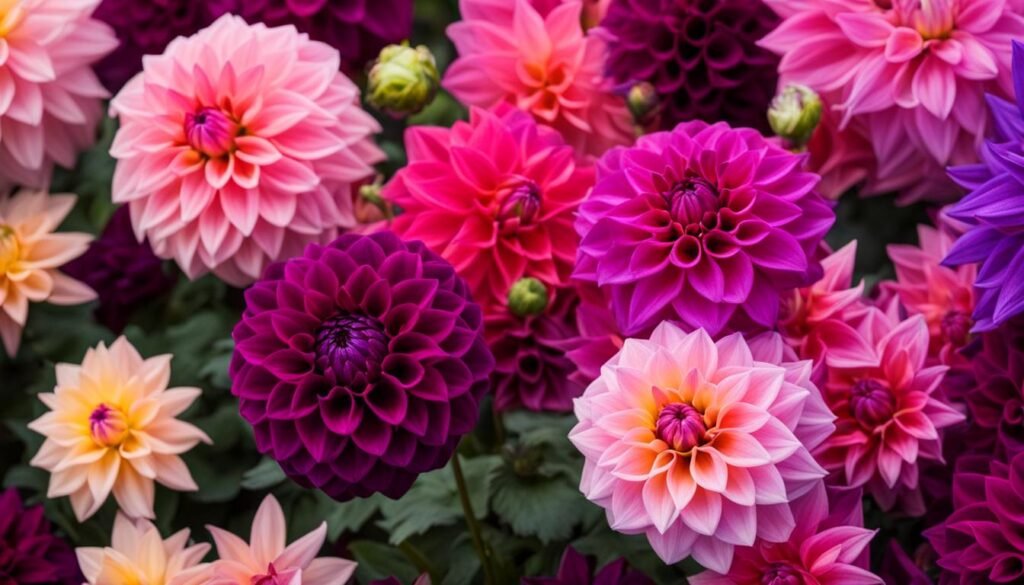
| Variety | Color | Size |
|---|---|---|
| Dinnerplate | Various | Up to 10 inches |
| Pompom | Various | 2-4 inches |
As shown in the table above, dahlias offer a splendid range of colors and sizes. From the dinnerplate dahlias with their impressive blooms that can reach up to 10 inches in diameter to the smaller, yet equally charming, pompom dahlias with their 2-4 inch flowers, there is something for every garden and personal preference.
Overall, dahlias are a delightful addition to any garden. Their ball-shaped pompom flowers, variety of colors and sizes, and love for sunshine make them a popular choice among gardeners. While they do require some maintenance such as staking and pest management, the reward of their exquisite blooms is well worth the effort. Whether enjoyed in the garden or cut for floral arrangements, dahlias are sure to evoke joy and admiration.
Chrysanthemums
Chrysanthemums are a popular choice for gardeners due to their bursts of color and beautiful ball-shaped blooms. They come in a variety of colors and sizes, making them a versatile addition to any garden. Whether you prefer vibrant oranges and yellows or delicate pinks and whites, there is a chrysanthemum to suit your taste.
To ensure your chrysanthemums thrive, it’s important to understand their sunlight and soil requirements. These plants prefer full sun to partial shade and well-draining soil. Provide them with the right conditions, and they will reward you with an abundance of stunning flowers.
“Chrysanthemums are a popular choice for gardeners due to their bursts of color and beautiful ball-shaped blooms.”
Proper Care for Chrysanthemums
Proper care is essential to keep your chrysanthemums healthy and vibrant. Here are some tips:
- Watering: Chrysanthemums should be watered regularly, keeping the soil evenly moist. However, avoid overwatering, as it can lead to root rot.
- Pruning and Deadheading: To promote bushier growth and prolong blooming, pinch back the tips of your chrysanthemums when they reach about 6 inches in height. Deadhead spent flowers to encourage new blooms.
- Overwintering: Chrysanthemums are perennial plants, but they may need protection during the winter months. In colder regions, consider mulching around the plants to protect their roots from freezing temperatures.
“Proper care is essential to keep your chrysanthemums healthy and vibrant.”
One of the great things about chrysanthemums is that they make excellent cut flowers. You can bring their vibrant colors indoors and create stunning floral arrangements. Whether you’re hosting a dinner party or just want to brighten up your living space, chrysanthemums are a perfect choice.
For a visual representation of the variety of colors and sizes chrysanthemums offer, take a look at the table below:
| Color | Size |
|---|---|
| Pink | Medium |
| Yellow | Large |
| Orange | Medium |
| White | Small |
As you can see, chrysanthemums offer a wide variety of colors and sizes, allowing you to create stunning floral displays in your garden or home. With proper care and attention, these beautiful ball-shaped blooms will continue to bring joy and color to your surroundings.
Viburnum Opulus
Viburnum Opulus, also known as guelder rose, is a delightful ornamental shrub that adds beauty to any garden. With its globe-like blooms, Viburnum Opulus is not only visually appealing but also low maintenance, making it a popular choice among gardeners.
This ornamental shrub is versatile and can tolerate a range of soil types, making it adaptable to various garden conditions. Whether your soil is sandy, loamy, or clay, Viburnum Opulus can thrive and produce its stunning globe-like flowers.
When it comes to sunlight requirements, Viburnum Opulus prefers full sun to partial shade. So, make sure to plant it in an area of your garden that receives adequate sunlight throughout the day.
One of the great things about Viburnum Opulus is its height. This shrub can grow up to 4m, adding a vertical element to your garden design. Its tall stature and globe-like blooms make it a standout feature among other plants.
As an ornamental shrub, Viburnum Opulus has various uses. You can use it as a focal point in your garden, planting it as a standalone specimen or as part of a mixed border. Its lovely blooms also make it suitable for cutting and using in floral arrangements to bring the beauty of the garden indoors.
Key Features of Viburnum Opulus:
- Ornamental shrub with globe-like blooms
- Low maintenance
- Tolerates a range of soil types
- Requires full sun to partial shade
- Reaches a height of up to 4m
- Great for ornamental use and cut flowers
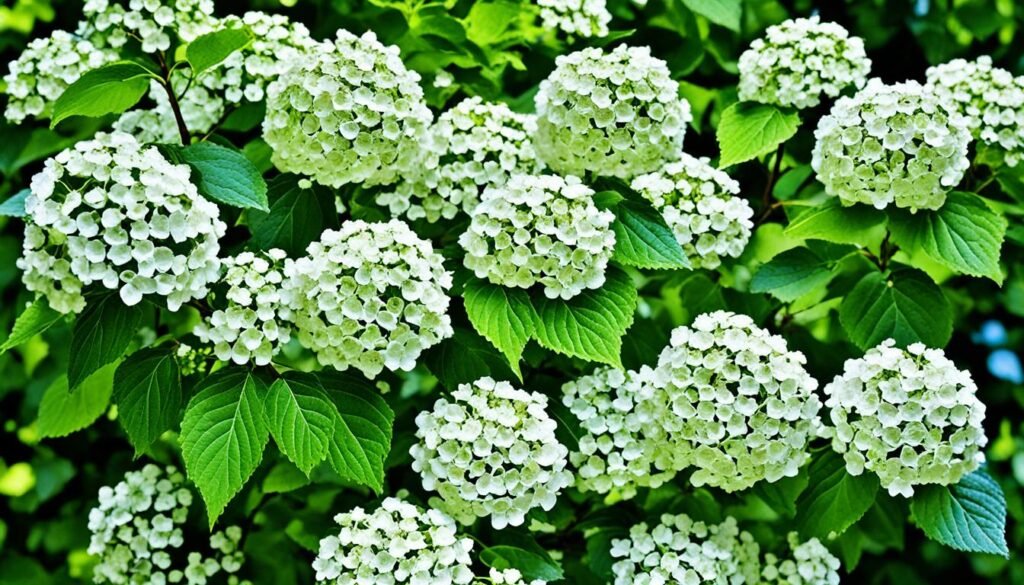
With its striking appearance, low maintenance nature, and versatile uses, Viburnum Opulus is a fantastic addition to any garden. Whether you’re creating a focal point or adding beauty to your floral arrangements, this ornamental shrub will not disappoint.
Globe Thistles
Globe thistles, also known as echinops, are unique and striking ball-shaped flowers. These tough and adaptable plants can withstand the harshest conditions, including drought, heat, and cold. What makes them truly captivating is their unique and striking appearance. The round flower heads of globe thistles create a mesmerizing focal point in any garden or floral arrangement.
Globe thistles thrive in a variety of environments, making them suitable for different garden settings. They prefer full sun to partial shade and require well-draining soil to ensure their optimal growth. With their ability to adapt, they can bring beauty to various landscapes, from sunny meadows to shaded corners.
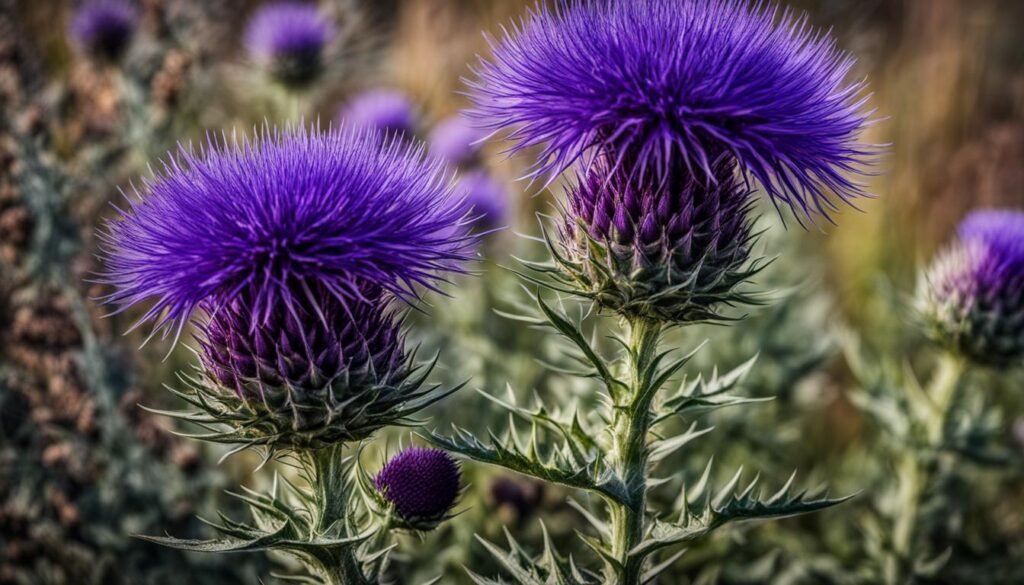
One of the key advantages of globe thistles is their low maintenance nature. Once established, they don’t require much attention or care. Their tough nature makes them excellent choices for busy gardeners or those looking for easy-to-grow plants. Simply plant them in the right spot, provide adequate water during dry spells, and enjoy the remarkable beauty they bring to your garden.
In addition to their aesthetic appeal, globe thistles are also beneficial for the ecosystem. These flowers attract pollinators such as bees and butterflies, enhancing the biodiversity of your garden and contributing to the overall health of the environment.
Hydrangea Arborescens Annabelle
Hydrangea Arborescens Annabelle, also known as smooth hydrangea, is a stunning addition to any garden with its ball-shaped clusters of white flowers. These beautiful blooms add a touch of elegance and charm to the landscape.
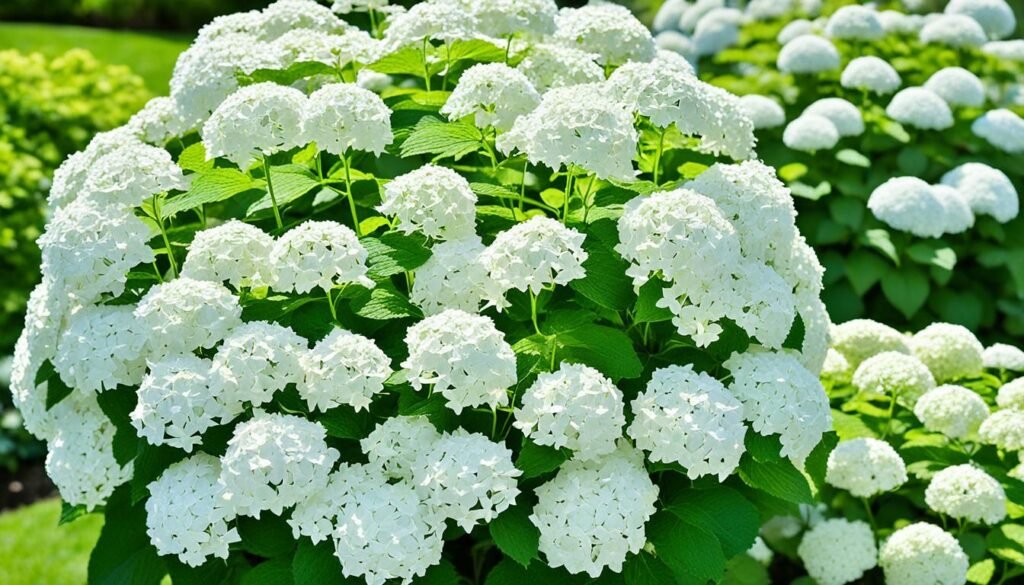
Hydrangea Arborescens Annabelle thrives in partial shade and moist ground conditions, making it an ideal choice for gardens with these characteristics. The plant’s ability to adapt to these environments allows for easy integration into existing landscaping plans.
This smooth hydrangea blooms on new wood, meaning it produces flowers on the current season’s growth. As a result, it can be pruned in late winter or early spring without compromising the blooming potential for the upcoming season.
One notable feature of Hydrangea Arborescens Annabelle is the color-changing nature of its flowers. While they start off as pristine white, they gradually change to a lovely green hue as they age. This color transformation adds visual interest and a touch of variety to the floral display.
| Characteristics | Requirements |
|---|---|
| Blooms | Ball-shaped clusters of white flowers |
| Landscape Conditions | Partial shade and moist ground |
| Blooming Cycle | New wood |
| Color Change | White to green |
Hydrangea Arborescens Annabelle is a versatile and visually appealing plant that can complement a wide range of garden styles. Whether used as a standalone focal point or incorporated into mixed flower beds, this smooth hydrangea is sure to impress.
Craspedia
Craspedia, also known as Billy Buttons, are unique and eye-catching ball-shaped flowers with bright yellow spherical flower heads. These charming flowers are sure to capture attention and add a cheerful touch to any garden. They thrive in full sun and well-drained soil, making them a perfect choice for sunny garden beds or containers.
Craspedia is a low maintenance plant that requires minimal care and attention. Once established, they are quite self-sufficient and continue to produce their eye-catching blooms with minimal effort. Their unique appearance makes them a standout feature in both garden beds and floral arrangements.

Growing Conditions and Maintenance
Craspedia thrive in full sun, so make sure to choose a planting location that receives at least 6 hours of direct sunlight each day. They also prefer well-drained soil that is rich in organic matter. Consider adding compost or well-rotted manure to the planting area before planting Craspedia to improve soil fertility and drainage.
These unique flowers are fairly drought-tolerant and can withstand dry periods, but they still appreciate regular watering, particularly during hot and dry spells. Avoid overwatering as Craspedia prefers slightly drier conditions.
When it comes to maintenance, Craspedia requires minimal attention. Deadheading spent flowers regularly will encourage continuous blooming. In colder regions, it is advisable to mulch around the base of the plant in late fall to protect it from harsh winter conditions. Craspedia can also be successfully grown in containers, providing a unique and eye-catching display on a patio or balcony.
Uses in the Garden and Beyond
With their striking appearance, Craspedia can be utilized in various garden design styles. They can be incorporated into mixed borders or rock gardens to provide a unique focal point. Additionally, Craspedia flowers are highly valued for their long-lasting qualities, making them a popular choice for cut flower arrangements. Their bright yellow color adds a cheerful touch to floral displays.
Whether you’re a novice gardener or a seasoned horticulturist, Craspedia, or Billy Buttons, are a fantastic choice if you’re looking for something truly unique and eye-catching to add to your garden. Their bright yellow spherical flower heads, low maintenance nature, and ability to thrive in full sun and well-drained soil make them a versatile and rewarding addition to any green space.
Other Bell-Shaped Flowers to Consider
In addition to the recommended ball-shaped flowers, there are other bell-shaped flowers that can add beauty to your garden. Some of these include:
- Marigolds
- Sea Pink
- Ornamental Onions
- Globe Thistles
- African Lilies
- Snowball Bush
- Globe Amaranth
- Persian Buttercup
- Sweet William
- Coneflower
- Japanese Camellia
- Bachelor’s Button
- Pincushion Protea
Each of these flowers has its own unique characteristics and requirements. They can add variety and charm to your garden, complementing the ball-shaped flowers recommended earlier. Incorporating a mix of these bell-shaped blooms will create a stunning floral display that is sure to impress.
Example Flower Attributes:
| Flower | Characteristics | Requirements |
|---|---|---|
| Marigolds | Bright colors, compact size, strong scent | Full sun, well-drained soil, moderate watering |
| Sea Pink | Low-growing, pink flowers, salt-tolerant | Full sun to partial shade, well-drained soil |
| Ornamental Onions | Spherical flower heads, various colors | Sun to partial shade, well-drained soil |
| Globe Thistles | Blue or purple globe-like blooms, attract pollinators | Full sun, well-drained soil, low maintenance |
| African Lilies | Lily-like flowers, vibrant colors, long bloom period | Full sun to partial shade, well-drained soil, regular watering |
| Snowball Bush | Large round clusters of white flowers | Full sun to partial shade, moist and well-drained soil |
| Globe Amaranth | Pom-pom-like flowers in various colors | Sun to partial shade, well-drained soil |
| Persian Buttercup | Brightly colored blooms, double or semi-double flowers | Full sun to partial shade, well-drained soil |
| Sweet William | Clusters of small flowers, various colors | Full sun to partial shade, well-drained soil |
| Coneflower | Daisy-like flowers with prominent cones | Full sun to partial shade, well-drained soil |
| Japanese Camellia | Elegant flowers in various colors | Partial shade, acidic soil, regular watering |
| Bachelor’s Button | Blue or pink flower heads, attract butterflies | Full sun, well-drained soil |
| Pincushion Protea | Unusual round flower heads with protruding styles | Full sun, well-drained soil |
These are just a few examples of bell-shaped flowers you can consider for your garden. Each flower has its own beauty and requirements, so it’s important to research and plan accordingly. Adding a mix of ball-shaped flowers and bell-shaped blooms will create a diverse and captivating garden display that will delight both you and your visitors.
Conclusion
Ball-shaped flowers, with their spherical blooms and round flowerheads, add a unique and eye-catching element to any garden. These globe-shaped blossoms, also known as orb flowers, are available in a wide range of colors, shapes, and sizes, making them versatile and suitable for all gardeners. Whether you opt for alliums, dahlias, chrysanthemums, viburnum opulus, globe thistles, hydrangea arborescens annabelle, Craspedia, or other bell-shaped flowers, you are guaranteed to infuse your garden with a touch of whimsy and beauty.
These flowery balls lend themselves beautifully to circular floral arrangements and can create stunning spherical floral displays that become the centerpiece of your garden. The sphere-like petals of these flowers create a visual impact that is both captivating and enchanting. Discover the joy of experimenting with different varieties of ball-looking flowers and witness the magic they bring to your outdoor space.
So, whether you are an experienced gardener or a novice, consider adding ball-shaped flowers to your garden. Their enticing charm and spherical beauty will not only attract pollinators but also bring a sense of wonder and delight to your outdoor oasis. Embrace the elegance of sphere-shaped floral arrangements and revel in the extraordinary allure of these captivating botanical gems.
